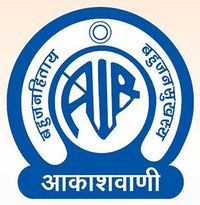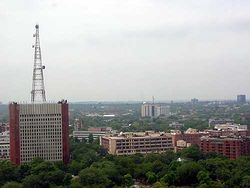All India Radio
 |
|
| Type | Government Organization |
|---|---|
| Country | India |
| Availability | National |
| Founded | by Government of India |
| Owner | Prasar Bharati |
| Launch date | 1936 |
| Official Website | www.allindiaradio.org |

All India Radio (abbreviated as AIR), officially known as Akashvani (Devanagari: आकाशवाणी, ākāshavānī), is the radio broadcaster of India and a division of Prasar Bharati. Established in 1936[1], today, it is the sister service of Prasar Bharati's Doordarshan, the national television broadcaster.
All India Radio is one of the largest radio networks in the world. The headquarters is at the Akashwani Bhavan, New Delhi. Akashwani Bhavan houses the drama section, the FM section and the National service. The Doordarshan Kendra (Delhi) is also located on the 6th floor of Akashvani Bhavan.
Contents |
History
In British India broadcasting started in June 1923 with programmes by the Radio Club of Bombay, followed by other radio clubs. Then, by an agreement of 1926 the private Indian Broadcasting Company (IBC) was granted permission to operate two radio stations; the Bombay station was inaugurated on July 23, 1927, the Calcutta station followed on August 26, 1927. But already on March 1, 1930 the Company went into liquidation. Thus the Government took over the broadcasting facilities, starting the Indian State Broadcasting Service (ISBS) on April 1, 1930 (on experimental basis for two years, but continued in May 1932). On June 8, 1936 the ISBS was renamed All India Radio (AIR; also known as Akashvani since 1956). On October 1, 1939 the External Service started (with a broadcast in Pushtu); it was designated to counter radio propoganda from Germany, directed to Afghanistan, Iran and Arab countries. When India became independent in 1947, the AIR network had only six stations: Delhi, Bombay, Calcutta, Madras, Lucknow, and Tiruchi; the total number of radio sets at that time was about 275,000. On October 3, 1957 the Vividh Bharati Service was launched to comptete with 'Radio Ceylon'. Television broadcasting began in Delhi in 1959 as part of AIR, but was separated from radio as Doordarshan on April 1, 1976.[2] FM broadcasting commenced on July 23, 1977 in Madras and was expanded in the 1990s.[3]
Services
AIR has many different services each catering to different regions/languages across India. One of the most famous services of the AIR is the Vividh Bharati Seva (roughly translating to "Multi-Indian service"). Vividh Bharati celebrated its Golden Jubilee on 3 October 2007. Vividh Bharati has the only comprehensive database of songs from the so termed "Golden Era" of Hindi film music (roughly from 1940s to 1980s). This service is the most commercial of all and is popular in Mumbai and other cities of India. This service offers a wide range of programmes including news, film music, comedy shows, etc. The Vividh Bharti service operates on different MW band frequencies for each city as shown below.
Some programs broadcast on the Vividh Bharti:
- Hawa-mahal - Skit (Radio Play) based on some novels/plays.
- Santogen ki mehfil - Jokes & humour.
Other services include:
- Primary Channel (regional - 115 stations[4])
- Local Radio Service (83 stations)
- National Channel (during nighttime; launched May 18, 1988; main frequency 1566 KHz from Nagpur)
- Home News Service (also via newsonair.com)
- External Services in 27 languages
- FM Channels (FM Rainbow - 12 stations, FM Gold - 4, FM Classical Music/Amrutha Varshini - 1)
The following is a partial list of AIR services.
East regional service
-_Kolkata_Center.jpg)
- Bhagalpur 1458 kHz
- Cuttack 'A' 972 kHz
- Darbhanga 1296 kHz
- Jamshedpur 1544kHs
- Kolkata 'A' 657 kHz
- Kolkata 'B' 1008 kHz
- Kolkata 'C' 1323 kHz
- Patna 'A' 621 kHz
- Ranchi 'A' 549 kHz
- AIR FM Kolkata has two stations 107FM Rainbow and 100.2FM Gold.
These stations broadcast live programmes in Bangla, English and Hindi. See http://kolkatarjratings.blogspot.com
North reginal Service
North-east regional service
- Agartala 1269 kHz
- Guwahati 'A' 729 kHz
- Shillong 864 kHz
West regional service
- Ahmedabad 'A' 846 KHZ
- Aurangabad 1521 kHz
- Bhopal 'A' 1593 kHz
- Chhindwara 102.02 MHz
- Chhatarpur 675 kHz
- Gwalior 1386 kHz
- Indore 'A' 648 kHz
- Jalgaon 963 kHz
- Mumbai 'A' 1044 kHz
- Mumbai 'B' 558 kHz
- Nagpur 'A' 585 kHz
- Panaji 'A' 1287 kHz
- Pune 'A' 792 kHz
- Rajkot 'A' 810 kHz
- Ratnagiri 1143 kHz
- Sholapur 1602 kHz
- Sangli 1251 kHz
South regional service
- Adilabad 1485 kHz
- Bangalore 'A' 612 kHz
- Chennai 'A' 720 kHz
- Coimbatore 999 kHz
- Gulbarga 1107 kHz
- Hyderabad 'A' 738 kHz
- Hyderabad 'B' 1377 kHz
- Kozhikode 'A' 684 kHz
- Madurai 1269 kHz
- Nagercoil101 MHzFM
- Udhagamandalam 1602 kHz,187.2meter(wave length)
- Pondicherry 1215 kHz
- Port Blair 684 kHz
- Thiruvananthapuram 'A' 1161 kHz
- Ananthapuri FM 101.9 MHz (from Thiruvananthapuram)
- Tiruchirapalli 'A' 936 kHz
- Tirunelveli 1197 kHz
- Vijayawada 'A' 837 kHz
- Visakhapatnam 927 kHz
- gautam456 kHz
External services
The External Services Division of All India Radio broadcasts in 27 languages to countries outside of India, primarily by high powered short wave broadcasts although medium wave is also used to reach neighbouring countries. In addition to broadcasts targeted at specific countries by language there is a General Overseas Service which broadcasts in English with 8¼ hours of programming each day and is aimed at a general international audience.
Yuv-vani: The voice of youth
The Yuv-vani service of AIR (launched July 21, 1969) provides an enriching and novel radio-experience by encouraging youth participation and experimenting with varied script ideas.It is broadcast at 1017 kHz which corresponds to 294.9 meter. Its Broadcast begins every evening this is not possible. i"In the groove" and "The Roving Microphone" which have been around for more than three decades, Yuv-vani still holds a firm ground of its own.
Some of the big names on the Indian media scene began their journey with Yuv-vani. Comments Praful Thakkar, a well known documentary maker - "Yuv-vani came as a breath of fresh air in our reckless college days. It was a great learning experience for me and it made me realize that radio is not all about goofy quotes and PJs."
Some of the other names that have been associated with Yuv-vani in the past include Celebrity game show host Roshan Abbas, VJ Gaurav Kapoor, Emcee Kshitij Sharma and DJ Pratham among others.
News-on-phone service
All India Radio, after launching the news-on-phone service on 25 February 1998 from New Delhi, is running the service from Chennai, Mumbai, Hyderabad, Indore, Patna and Bangalore also. The service is accessible through STD, ISD and local telephone calls. There are plans to establish the service in 9 further cities — Ahmedabad, Bhopal Guwahati, Gwalior, Jabalpur, Jaipur, Kolkata, Lucknow, Ranchi, Simla and Thiruvanthapuram shortly.
English and Hindi hourly news bulletins can be heard live on http://www.newsonair.com. The news in MP3 format can be directly played from the site. In the file name the hourly time of news is mentioned. Text of the English and Hindi bulletins can be read from http://www.newsonair.com/BulletinsInd.html.
AIR news bulletins are available in 9 regional languages (Tamil, Kannada, Gujarati, Bengali, Marathi, North East, Punjabi, Telugu, Urdu) from http://www.newsonair.com/index_regional.htm.
Controversy
During his regular broadcasts from the Azad Hind Radio, Subhas Chandra Bose used to refer to the pre-independence AIR as Anti Indian Radio.
References
- ↑ About us Official website. allindiaradio.org. Retrieved:2008-08-03.
- ↑ AIR Manual, Chapter 1: History of All India Radio
- ↑ http://allindiaradio.org/milestone.html
- ↑ http://allindiaradio.org/FACTS.html
External links
- All India Radio Official web-site
- Know India: Radio
- AIR's Frequency schedule
- All India Radio (AIR) Station Frequencies (National/International)
- Children's wing of All India Radio
